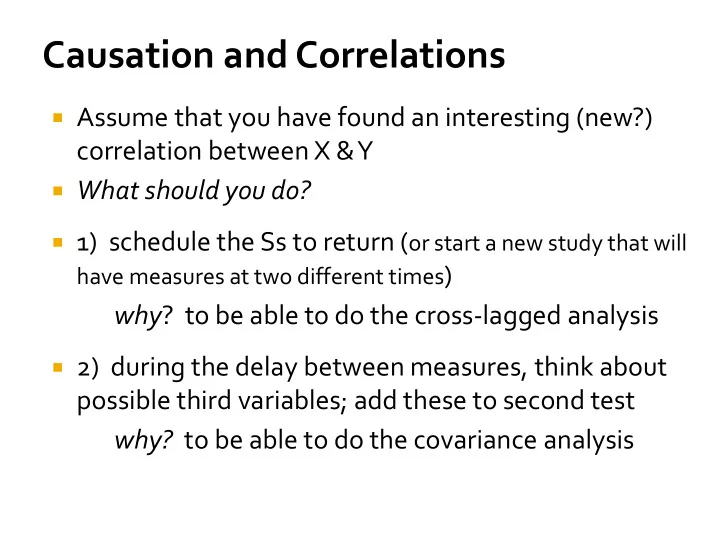

Causation and Correlations Assume that you have found an interesting (new?) correlation between X & Y What should you do? 1) schedule the Ss to return ( or start a new study that will have measures at two different times ) why ? to be able to do the cross-lagged analysis 2) during the delay between measures, think about possible third variables; add these to second test why? to be able to do the covariance analysis
Partials & Spurious Correls theory-driven approach if the X-Y correlation is spurious via Z then prXY • Z will be zero if the X-Y correlation does not involve Z then prXY • Z will be the same as rXY data-driven approach if prXY • Z = rXY then the X-Y correlation is not spurious via Z if prXY • Z is zero then the X-Y involves Z ( or a correlate of Z )
Sampling how do you choose a method? ask yourself how important it is to have a sample that accurately represents the target population if “not very”: convenience if “sort of”: simple random sampling if “very”: stratified random sampling then make sure that the method you selected won’t run into any statistical issues
Choosing a Correlational Method Surveys Observation What are you trying to measure? attitudes, values, beliefs, behavior and other unobservable attributes Is reactivity a serious problem? Is realism important? no yes Are you willing to invest time/effort? no yes
Aging Research Hybrid Design 1 younger comparison #2 younger older comparison #1 if comparison #2 ( w/ cohort problem ) finds the same as comparison #1 ( w/ time-frame problem ), then OK i.e., if the two “younger” data same, all is well
Definitions ( and more ) Naturalistic Observation – studying behavior in everyday environments without getting involved key threat: reactivity (secondary: observer bias) Participant Observation – studying behavior from within the target group key threats: reactivity + std. exptr bias (secdry: obsr bias) note: Partic.Obs. is not often possible, since no-consent observation can only occur when and where there is no reasonable expectation of privacy Observer Bias – when the beliefs or expectancies of the observer ( consciously or otherwise ) influence what is recorded – note: inter-coder reliability must be . 90 +
Last-minute Questions 10 pm on Wed evening: http://www.justin.tv/directory/science_tech look for “ Uipsymeth ” stream if it asks for password: “exam3”
Recommend
More recommend